Posts Tagged: sunflowers
Stunting Sunflower Growth
I know this post will ultimately make a lot of you cringe at what I do. But just as art is in the eye of the beholder, the joy of gardening, whether done the right way or the wrong way, is in the hands of the individual. And as individuals, we often do things differently.
There are proper ways to stunt or control plant height and growth practiced by greenhouse growers. These methods employ either use of either a chemical plant growth retardant (http://www.extension.purdue.edu/extmedia/HO/HO-248-W.pdf), or environmental or cultural control methods (http://extension.umass.edu/floriculture/fact-sheets/controlling-plant-height-without-chemicals). But what I’m writing about below is not the proper way to do things, but it’s what I do to suit my needs. So here goes.
For years I grew rows of Mammoth Sunflowers (Helianthus annuus) in my backyard simply because the flowers are so cheerful. I love the structure of a sunflower, and don’t really care about the size of the flower or the seeds. But a few years ago when my neighbor stopped plowing my backyard for me because he stopped farming, I reached the point where I was tired of digging up the enormous sunflower plants and chopping up the thick ten to twelve foot stalks at the end of each season. I decided it wasn’t worth the physical effort to grow them in my backyard anymore.
So the last couple years I’ve been planting sunflower seeds in impromptu planters. No, not the seeds for dwarf sunflowers, but the seeds for full sized sunflowers. Why don’t I just plant the seeds for dwarf sunflowers? Two simple reasons: cost and availability. I can always buy a packet of sunflower seeds for a quarter or less at my local dollar store. The dwarf sunflower seeds, which produce beautiful lush plants and flowers, are more expensive and I usually have to hunt for the seeds at local retailers or end up purchasing them through the mail.
By planting the seeds for full sized sunflowers in planters, I intentionally stunt their growth so that I end up with miniature, albeit not the healthiest looking plants. But the plants take up little space and the baby sunflowers still make me smile. And since earlier this year a friend sent me some steaks that the company shipped in styrofoam coolers, I decided to recycle the bottoms of the coolers and turn them into planters. So I punched holes in the bottom of them, added some soil, and the photos below show my stunted sunflower plants which are just starting to bloom.
If you want to grow sunflowers in planters, you should purchase dwarf sunflower seeds suited for container gardening. The reason I shared with you what I do is to illustrate you should never be afraid to experiment in your gardening, be it trying a new method, or growing something you’ve never grown before. Adapt your gardening practices to meet your own needs. And regardless of whether something turns out right or wrong, gardening should always bring you joy. So have fun in your garden!
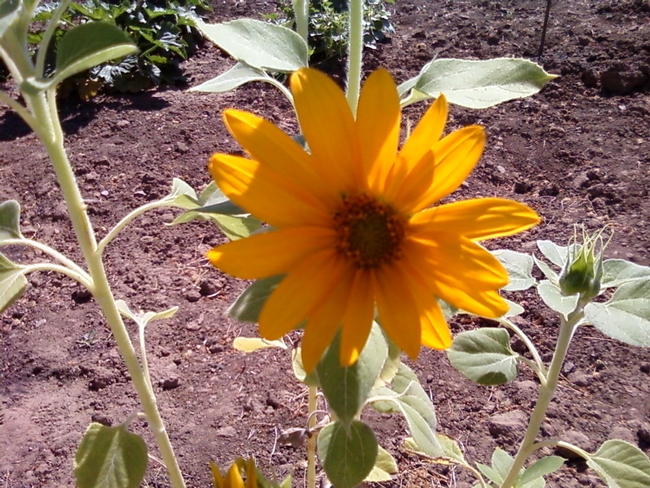
Stunted mammoth sunflower. (photos by Kathy Low)
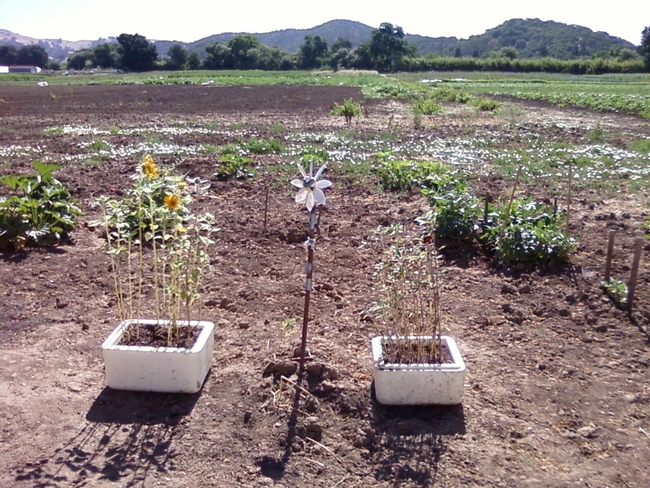
Sunflowers planted in impromptu planters.
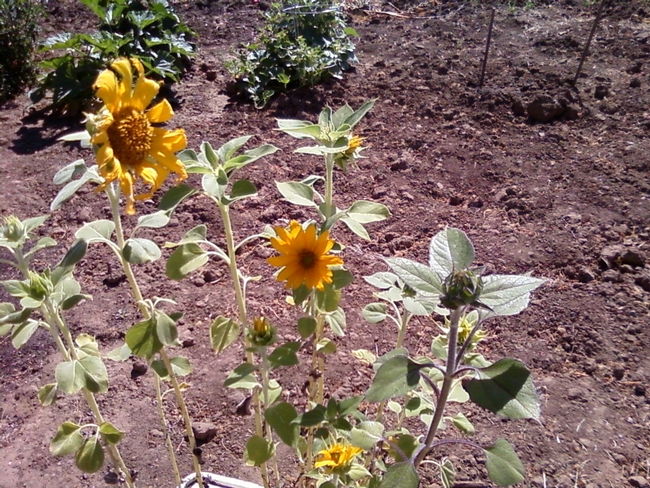
Sunflowers starting to bloom.
Sunny-Side Up
You can tell it's summer along Yolo County roads by the acres and acres of sunflower fields. Looking like real-life Van Gogh paintings (Van Gogh...
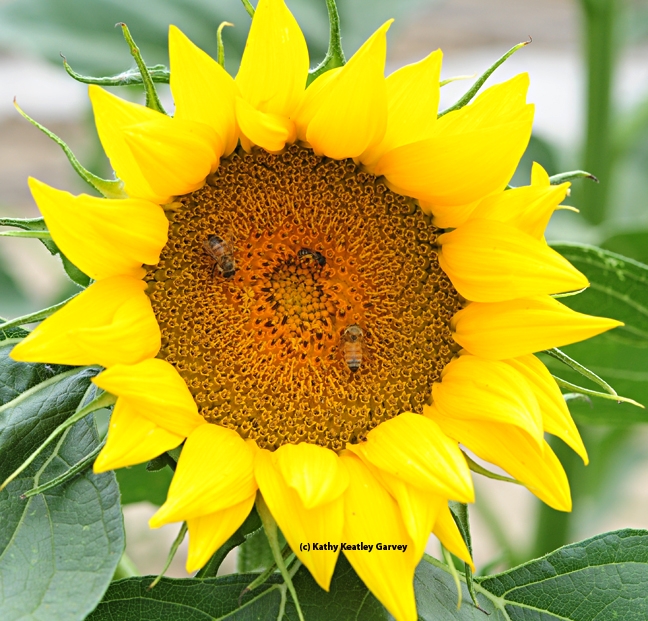
Honey bees and a sunflower bee forage on a sunflower head. (Photo by Kathy Keatley Garvey)
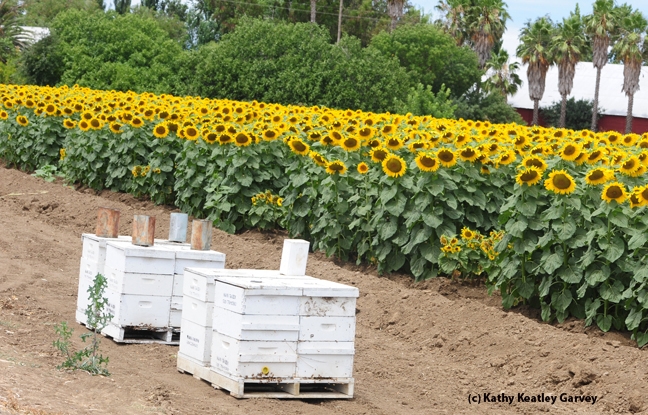
Bee boxes line a sunflower field. (Photo by Kathy Keatley Garvey)
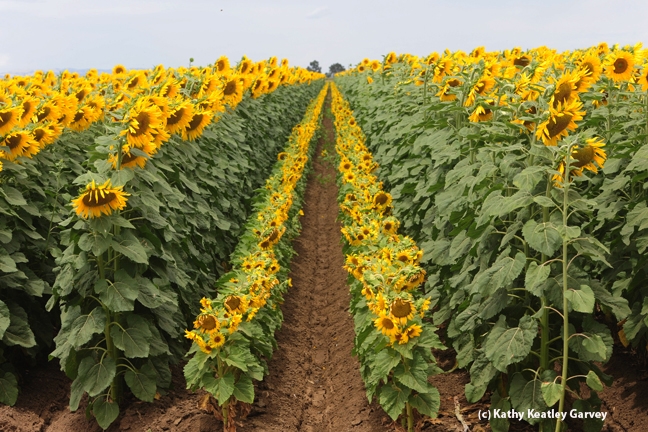
A spectacular sunflower field. (Photo by Kathy Keatley Garvey)
How NOT to Grow Giant Sunflowers
A few years ago, we grew a mammoth sunflower that my son has talked about ever since. We had planted it in our raised vegetable bed so it had good sun, good soil, and a good water supply. Unfortunately, it wasn’t so good for the vegetables that struggled to compete with it!
We have tried to grow giant sunflowers every year since in other areas of the yard that didn’t require sacrificing a zucchini plant or a tomato crop. But perhaps due to the clay soil, more sporadic irrigation, or hungry birds or squirrels, we couldn’t even get the seeds to germinate.
So this year, I gave up a corner of my raised vegetable bed to growing a giant sunflower again for my son. The seeds germinated quickly and the seedlings happily grew . . . and then we went on vacation. When we returned, the seedlings were so big that I was reluctant to thin them for fear of disturbing the roots of their siblings. (That, and I’m a bit too soft-hearted to thin seedlings like I know I should.) Giant sunflowers should be space 20-24” apart. If they are planted too closely, the seed head will be smaller.
Ultimately, instead of a giant sunflower, we have ended up with a crop of 5 very tall sunflowers with good-sized—but definitely not giant—seed heads. Being contrary flowers, they prefer to face our sunnier neighbor’s yard than our own. We didn’t get the mammoth sunflower that we were hoping for, but I have to admit, the cheery faces of the sunflowers that we do have more than make up for it. Plus, I know my finches will be happy when the seeds ripen! It was definitely worth worth skipping a few zucchini this year.
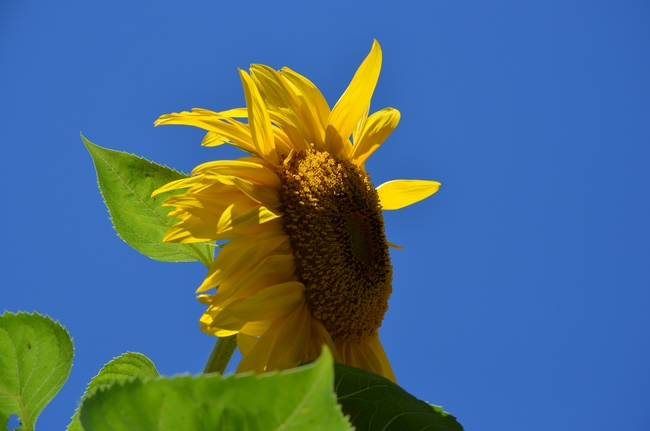
Giant sunflower. (photo by Erin Mahaney)
Fisheye View of the Garden
When I was teaching photography, I encouraged my students to go for the angles--from a bug's eye view to a bird's eye view. Holding a camera...
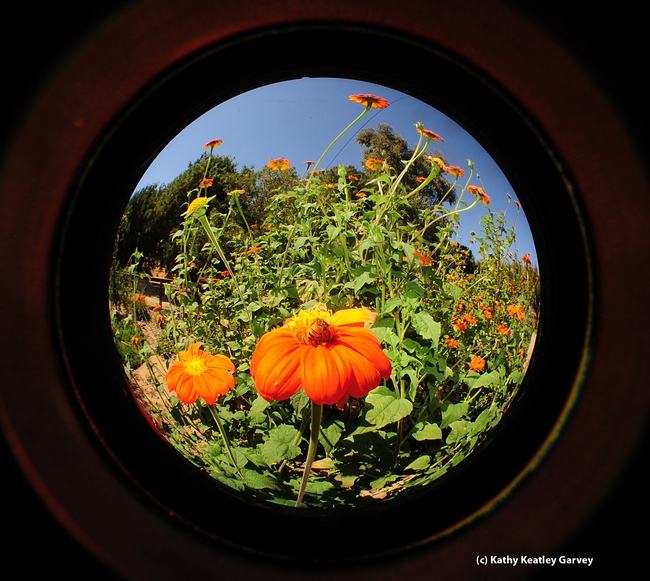
Fisheye of Mexican sunflowers (Tithonia) in the Haagen-Dazs Honey Bee Haven. (Photo by Kathy Keatley Garvey)
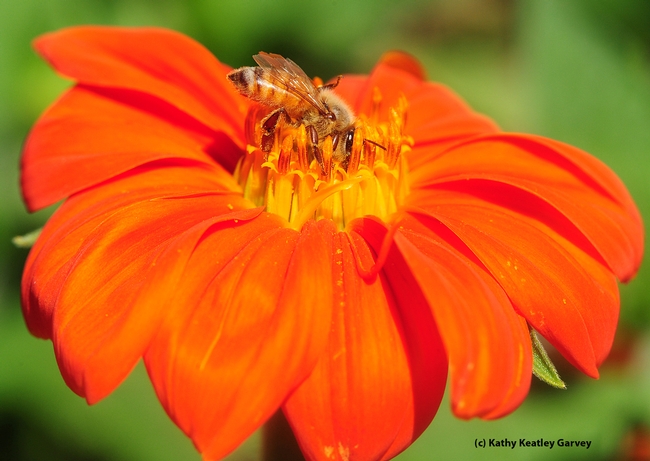
A honey bee foraging on a Mexican sunflower (Tithonia). (Photo by Kathy Keatley Garvey)
Sunny Sunflowers
Well, I am trying again to grow sunflowers. Here is my result so far. Skinny little bits, hardly a flower at all and very slow incoming. I've thinned out the starts now 3 times, to give the stronger sprouts more space. We'll have to see if they ever take off.
On the other hand here is my volunteer that showed up in the middle of the garden path. Oh well, at least there is one sunflower in the garden.

Sunflower weaklings. (photos by Trisha Rose)
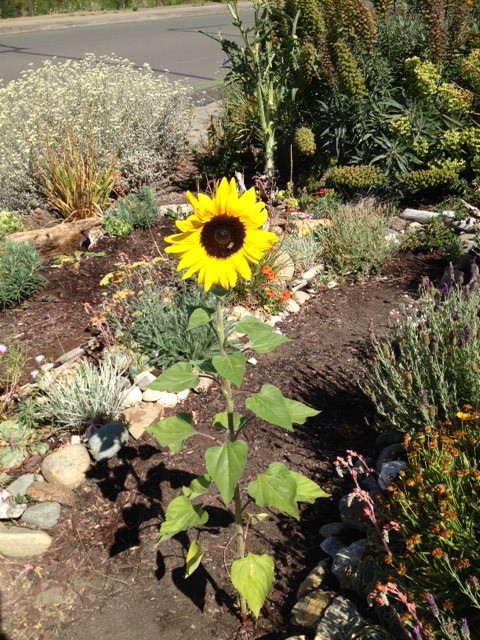
Happy volunteer sunflower.

